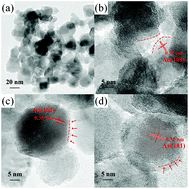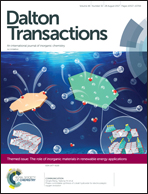The origin of enhanced photocatalytic activities of hydrogenated TiO2 nanoparticles†
Abstract
The photocatalytic activity of semiconductors is largely governed by their light absorption, separation of photoinduced charge carriers and surface catalytically active sites, which are primarily controlled by the morphology, crystalline size, structure, and especially the electronic structure of photocatalysts. Black TiO2 is recognized as one of the most promising visible-light photocatalysts, due to its significantly enhanced visible-light photocatalytic performance in comparison to intrinsic TiO2. In this work, black TiO2 is synthesized through the hydrogenation process. The sample shows a TiO2@TiO2−x core/shell structure which is attributed to hydrogenation. By using X-ray photoelectron spectroscopy (XPS), X-ray absorption spectroscopy (XAS), and nuclear magnetic resonance (NMR) spectroscopy, we identified the featured midgap electronic states in black TiO2, which gave rise to the TiO2−x shell layer. These states lead to the improvement of visible-light absorption and the separation of photoinduced charge carriers, which consequently result in remarkable enhanced photocatalytic activities in black TiO2.

- This article is part of the themed collection: The Role of Inorganic Materials in Renewable Energy Applications


 Please wait while we load your content...
Please wait while we load your content...